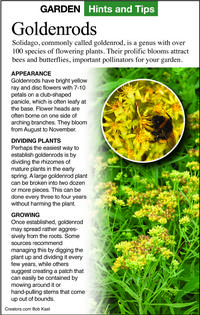The Greener View: Goldenrod
Have you seen yellow flowering plants along the side of the road or in people's gardens? They are probably goldenrods. Last week, I talked about the hidden green flowers of ragweed that are the culprits behind hay fever. I mentioned that goldenrods often get the blame, so let's talk about goldenrods.
Are they a wildflower or a weed? Many people know the name goldenrod, but the plant they are calling goldenrod may not be the same as someone else's goldenrod. There are over 100 species in the Solidago genus in the aster family that are goldenrods, but there are several other genera in the aster family that are called goldenrod. Plus, there are other plants that are not in the aster family that are called goldenrods, such as woolly mullein.
These are herbaceous perennials that spread by rhizomes and stolons to form large clumps of the same plant. They can be very weedy in the garden, but they are very good plants in natural areas. Some species grow over 7 feet high, and some are only 1 foot tall. Different species grow in many soil types, from swampy to dry, and in full sun to shade. They are very hardy, and almost all of North America has at least one species.
They are late summer and fall bloomers that work well with blue and purple flowering asters. The flower clusters are various shades of yellow, and some are white. They attract many species of pollinating insects with their sticky pollen. They are not wind-pollinated, so they do not contribute to hay fever allergies, as many people believe. They bloom at the same time as ragweed, and these two plants may bloom right next to each other. Ragweed has green flowers and wind-blown pollen. But no one sees the green flowers on ragweed, and so they blame their symptoms on the plant they do see blooming. Watch my videos on goldenrod and ragweed for more information.
On the other hand, some people have used goldenrod as a medicinal plant. Amazingly, Henry Ford, George Washington Carver and Thomas Edison all worked on ways to make rubber from the leaves of goldenrod plants.
Goldenrod species are used as a food source by many butterfly species. Some species of insects cause the plant to form a bulbous tissue mass called a gall. The insect may feed in the gall, or it may pupate and spend the winter in the gall. Various parasitoid wasps find these galls and lay eggs in the larvae, penetrating the bulb with their ovipositors. Woodpeckers are known to peck open the galls and eat the insects in the center.
If you need a yellow flower in the fall garden, consider using a goldenrod, knowing that 1) they do not contribute to allergies, and 2) they can become weedy in the garden.
========
Email questions to Jeff Rugg at info@greenerview.com. To find out more about Jeff Rugg and read features by other Creators Syndicate writers and cartoonists, visit the Creators Syndicate website at www.creators.com.
Copyright 2025 Jeff Rugg. Distributed By Creators.








Comments